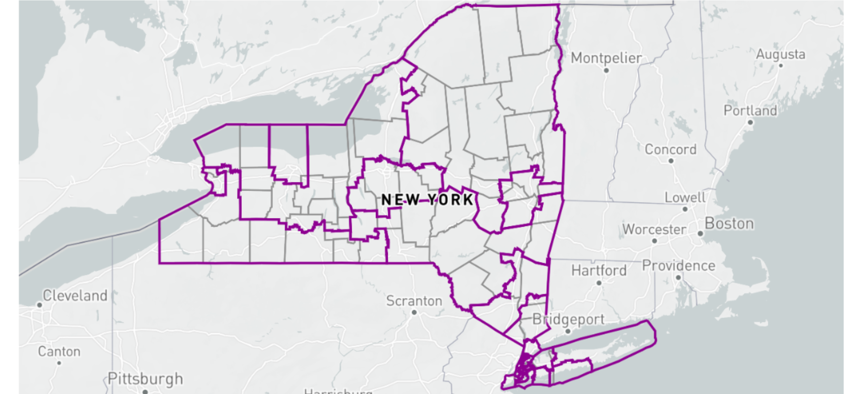Albany Agenda
Are we really talking about redistricting again?!
Despite what you may hear, a mid-decade redistricting in New York is both very difficult and very unlikely.

New York’s current congressional districts, which we are probably stuck with until 2032. The Graduate Center at CUNY and Redistricting and You
With the Texas state Legislature planning to redraw its congressional lines ahead of next year’s midterm elections in order to help maintain a Republican majority in the House, chatter has started in New York about doing the same, only to help Democrats win back the chamber. Politico New York reported that House Minority Leader Hakeem Jeffries has spoken to Gov. Kathy Hochul about the prospect, and Hochul herself did not rule out the idea when asked. But the process would be neither straightforward, nor timely given current state constitutional limitations.
There are no federal laws that can stop a state from drawing new district lines outside of census years. The only restrictions come from laws within the state itself. Unfortunately for New York Democrats, the state constitution expressly prohibits mid-decade changes, while Texas law gives Republicans there free range to adopt new lines, despite the controversy the move is already stirring. Per the New York constitution, a reapportionment plan “shall be in force until the effective date of a plan based upon the subsequent federal decennial census.” In other words, no new census data, no new lines. (The next census will not take place until 2030.)
“But wait,” you may be thinking, “didn’t we adopt new lines in 2024 right after an earlier round of redistricting in 2022?” And you’d be right! The state constitution has an exception in the case of a court order requiring the redrawing of lines. And New York had lawsuits aplenty during the 2020 census redistricting process. Ultimately, Democrats succeeded in one of the suits they brought against the validity of districts drawn by a court-appointed expert, with the state Court of Appeals deciding that the Independent Redistricting Commission was allowed another chance to draw congressional lines as laid out in the state constitution. The commission did that, and even approved of the map in a bipartisan fashion, before Democrats in the Legislature rejected it in favor of a similar one that they drew themselves. Those are the districts currently in use.
You’d be forgiven if you don’t want to go through even more years of confusing redistricting limbo. And even if you do, the likelihood that Democrats could even do anything before the congressional elections next year is so close to impossible that any attempt could simply be a frustrating exercise in futility.
The most straightforward option would be to change the state constitution to allow for mid-decade redistricting. But that wouldn’t yield results until the 2028 elections, which does Democrats little good if they hoped to strengthen their numbers in the House next year. The process of amending the state constitution is long and drawn out; two different classes of lawmakers must approve a state constitutional amendment and then voters must ratify the amendment. Even if legislators came back for a special session this year to approve the amendment, the earliest such a proposal could head to voters is 2027. And it’s not even clear that voters would support the proposal. In 2021, voters rejected tweaks to the reapportionment process that would have given Democrats more control over redistricting.
Democrats’ next option would be to find someone that would challenge the current map based on an alleged shortcoming in meeting required criteria. That would necessitate Democrats effectively suing themselves, given the fact that state lawmakers both drew and approved the current congressional districts. A lawsuit also would require a series of fortuitous decisions if Democrats wanted a new map by next year’s election, including a favorable ruling at the trial level, a speedy process to the likely appeal and a quick deadline for new maps. This would be uncharted territory, but chances are the Independent Redistricting Commission would once again need to submit possible maps before state lawmakers could try their hand at redistricting themselves. And if they managed to get that far, Democrats don’t even have the necessary two-thirds majority in both chambers that would be needed to approve a new map. And all this comes before potentially more lawsuits if Democrats attempt a heavy-handed gerrymander.
If all else fails Democrats could always take a page out of the Trump playbook: ignore the law and court orders and simply press ahead with partisan changes that would violate state rules against mid-decade reapportionment and partisan gerrymandering. This would offer the fastest route to achieve new maps, but it would also present the most risk. Such a move would surely attract quick legal action from both Republicans and good government groups who have fought for years to take politics out of redistricting. Given Democrats’ court loss the last time they drew congressional maps that appeared to favor their own party, precedent would not be in their favor. Such a move would also require buy-in from legislative leaders, which one knowledgeable source said is exceedingly unlikely.
NEXT STORY: Opinion: Mamdani’s test on policing

